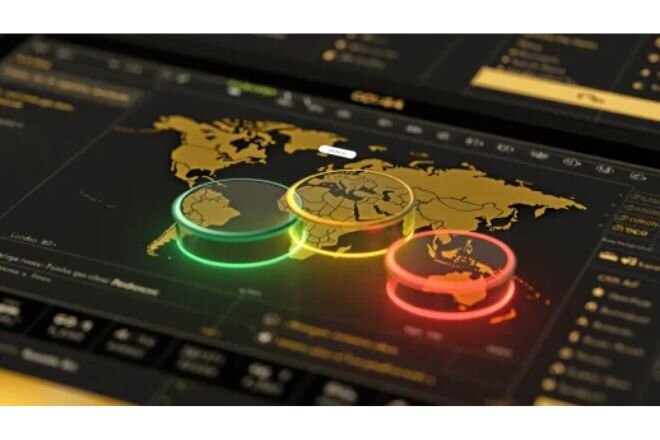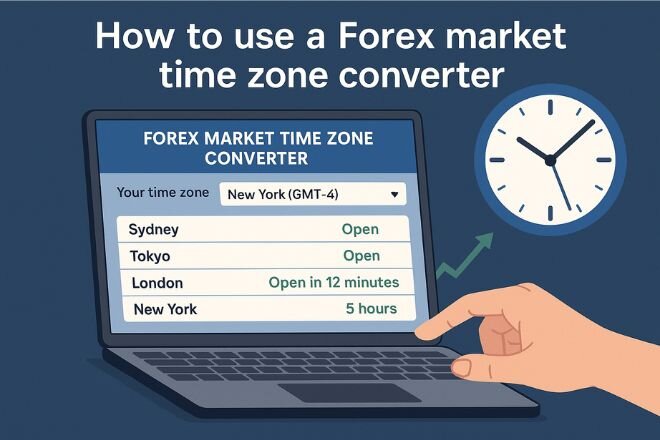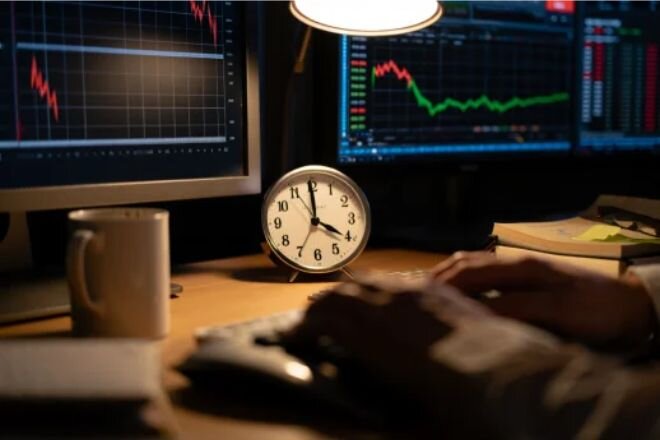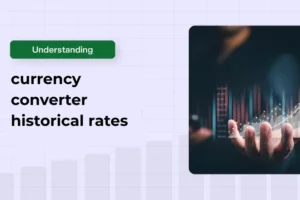The forex market operates 24 hours a day, five days a week. But that doesn’t mean all trading hours are created equal. Have you ever missed a perfect setup simply because you got the timing wrong? Or worse, placed a trade during a session when liquidity was bone dry? If so, you're not alone. That’s where a forex market time zone converter becomes a game changer.
In this guide, we’ll explore why understanding time zones is crucial for forex traders, how to use a forex market time zone converter effectively, and how to align your strategy with global trading sessions. Let’s dive in.
1. What is a Forex market time zone converter?
In simple terms, a forex market time zone converter is a digital tool that helps forex traders track the exact opening and closing times of global trading sessions based on their local time zone.
Forex is a decentralized global market that operates 24 hours a day from Monday to Friday. However, it’s divided into four major trading sessions Sydney, Tokyo, London, and New York each located in a different time zone. This creates a significant challenge for traders living in other regions who may struggle to convert those times accurately.
1.1 Definition and purpose of a Forex market time zone converter
A forex market time zone converter is a specialized digital tool designed to help traders navigate the global nature of the forex market by displaying the opening and closing times of major trading sessions in their own local time.
Since the forex market operates 24 hours a day across different continents and time zones, timing is everything and this tool solves one of the most common and overlooked problems in trading: time zone confusion.

Why is it so important?
The forex market isn’t centralized; instead, it moves across global financial hubs Sydney, Tokyo, London, and New York each of which opens and closes based on its own local time. As a result, if you're a trader in Southeast Asia, Africa, or South America, you might find it tricky to know:
- When the London market opens in your local time
- When the New York session overlaps with London (the most volatile trading window)
- When the market is flat, due to low liquidity periods
Without a forex market time zone converter, traders risk placing orders when markets are inactive, spreads are wide, or price action is slow ultimately harming their performance.
What this tool helps you do
A good forex market time zone converter enables traders to:
- Translate global forex market hours into your local time zone, instantly and accurately
- Identify the most active trading sessions in real time, so you can plan trades around high liquidity windows
- Automatically adjust for daylight saving time (DST) changes in countries like the United States or the United Kingdom, something many new traders forget to consider
- Plan trades during session overlaps, especially the London New York overlap, known for fast price movements and tighter spreads

This is especially useful for traders in time zones like UTC+8 (Singapore, Philippines), or UTC-3 (Brazil), where the most active trading hours often fall outside traditional working hours.
Real time accuracy without guesswork
One of the key benefits of a forex market time zone converter is that it removes the guesswork entirely. No more Googling “What time does the London session open in my country?” or manually counting backward from GMT.
Instead, you get:
- A real time interface that shows you exactly when each session opens and closes
- An interactive world clock or calendar that aligns your trading schedule with market activity
- A clear roadmap to determine when not to trade, helping you avoid the “dead zones” of the market
The strategic advantage
Timing is not just about availability it’s about strategy. With a converter, you can:
- Build your daily trading plan based on when the market moves the most
- Set alerts before key sessions open or major economic events occur
- Conserve energy and focus, trading only during peak windows instead of monitoring charts 24/5
Using a forex market time zone converter isn’t just convenient it’s smart trading. In a game where seconds and precision matter, this tool helps you operate with professionalism, discipline, and accuracy. Whether you're a full time trader or a part time investor, integrating it into your workflow will drastically improve your timing and performance.
1.2. Real life example: a trader in Europe
Let’s say you’re based in Germany, a central location in Europe operating on UTC+1 during standard time and UTC+2 during daylight saving time. You want to align your trading activities with the most active sessions of the forex market specifically the London and New York sessions, which offer the highest liquidity and most price action.
But here’s the challenge:
You might assume the New York session opens at 2:00 PM your time. However, that changes depending on the season, because both the US and Europe follow different DST schedules. Mistiming this could mean entering the market too early or too late—missing out on optimal volatility.
Using a forex market time zone converter, you can clearly see:
- London session opens at 9:00 AM local time (Germany)
- New York session opens at 2:30 PM local time during DST, or 3:30 PM outside DST
- The London–New York overlap runs approximately from 2:30 PM to 5:00 PM or 3:30 PM to 6:00 PM, depending on DST adjustments
This real time precision helps you trade smarter, not harder.
In summary, a forex market time zone converter is more than just a clock it’s a trader’s strategic ally. By translating global market hours into your local time, it helps you avoid costly timing mistakes, plan smarter trades, and stay aligned with the most active sessions. If you want to maximize your trading edge, this tool should be part of your daily routine. Don’t trade in the dark trade with precision.
2. Why do you need a time zone converter in Forex trading?
Forex trades 24 hours a day, five days a week but are you trading during the market’s golden hours? The truth is, not all hours in the forex market are created equal. While currency pairs can technically be traded at any time, smart traders know that timing is everything.

Reasons why you need time zone converter in Forex trading
2.1 The 24/5 nature of Forex: Constant movement, but not constant opportunity
Forex is a decentralized global marketplace that never sleeps from Monday to Friday. That means at any given moment morning in Tokyo, afternoon in London, or late evening in New York currencies are being bought and sold. However, just because the market is open 24/5 doesn’t mean every hour is equally profitable.
The most lucrative opportunities often occur during key overlaps, such as when the London and New York sessions are active at the same time. These windows offer the highest liquidity and volatility ideal conditions for scalpers, day traders, and even swing traders.
2.2 The Problem: Time Zone Confusion Is Costing Traders Money
Here's the catch: due to different time zones and seasonal daylight saving adjustments, many traders struggle to determine exactly when these sessions begin and end in their local time. Misjudging session open times even by one hour can lead to missed trades, late entries, or trading in low-volume "dead zones."
For example, if you’re based in Asia and want to catch the New York session, do you really know whether it starts at 8:00 PM or 9:00 PM local time this month? If you’re in South America, is the London session opening at 4:00 AM or 5:00 AM? These variations, especially during daylight saving transitions, make it hard to stay on top of session timings manually.
2.3 The solution: Use a Forex market time zone converter
This is where a forex market time zone converter becomes your best trading companion. It automatically syncs your local time with global trading sessions, removing the need for constant manual calculations or unreliable Google searches. Whether you're in UTC+7, UTC-5, or anywhere in between, a converter gives you real time accuracy.
With a reliable converter, you can:
- Know exactly when the London session opens in your city: This means you'll be able to pinpoint the exact time the London trading session begins in your local timezone, whether you're in Asia, Africa, or South America.
- Plan trades during high liquidity overlaps, like London-New York: This refers to organizing your trading schedule around the periods when multiple major markets are open simultaneously, such as the overlap between the London and New York sessions.
- Avoid low-volume periods when spreads widen and price action slows: This means staying away from quiet market hours like late night or early morning when fewer traders are active and price moves are sluggish.
- Adjust seamlessly for daylight saving time changes: A reliable forex market time zone converter automatically accounts for daylight saving time (DST) changes in countries like the US and UK.
A forex market time zone converter does more than save time it simplifies your trading, reduces mistakes, and keeps you focused on the most profitable hours. Whether you’re new or experienced, it’s a must have tool for navigating the 24 hour forex market.
See more useful additional articles:
- How to Use Fibonacci Retracement: A Practical Guide for Traders
- Gold Price Plunges Nearly 2% as Investors React to Trump’s EU Tariff Delay
- China Risks Deeper Deflation as U.S.-Bound Exports Flood Domestic Market
3. How to use a Forex market time zone converter
If you're based in Europe, timing is everything. While the London session overlaps conveniently with your working hours, the New York session may begin in the afternoon and that’s where the real price action kicks in.

Here’s how to use a forex market time zone converter to take full advantage of your European location:
Step 1: Set Your Local Time Zone (e.g., Germany – UTC+1 or UTC+2 DST)
Make sure the converter reflects your current time zone. In countries like Germany, France, or Italy, daylight saving time shifts between UTC+1 (standard) and UTC+2 (summer). Many traders forget this adjustment leading to costly mistakes.
Tips: Double check DST settings during March and October transitions to ensure you're syncing with U.S. and U.K. markets correctly.
Step 2: Choose the Sessions You Want to Track
Most European traders focus on:
- London session (9:00 AM – 6:00 PM local time)
- New York session (starts around 2:30 PM or 3:30 PM depending on DST)
- London–New York overlap (typically 2:30 PM to 5:00 PM or 3:30 PM to 6:00 PM)
These windows offer the highest liquidity, tight spreads, and strong price movements, especially for pairs like EUR/USD, GBP/USD, and USD/CHF.
Step 3: Use the Converter Output to Plan Trades
Once you see local session times, here’s how to apply them:
| Session | Time in Berlin/Paris (CET/CEST) | Strategic Note |
| London | 9:00 AM – 6:00 PM | Core trading hours, ideal for GBP & EUR |
| New York | 2:30 PM – 11:00 PM (DST) | Great for major news releases |
| London–New York Overlap | 2:30 PM – 5:00 PM (or 3:30 PM – 6:00 PM) | Best time for momentum trading |
My Advice: Use this overlap to trade breakouts or major news releases (like U.S. CPI, FOMC statements, or ECB updates).
Why this matters for European traders
Using a forex market time zone converter allows European traders to:
-
- Precisely schedule trades around key market events: In Europe, many important regional economic releases (such as ECB decisions, EU inflation data) happen in the morning or early afternoon. Meanwhile, major U.S. news often comes out at 2:30 PM – 3:30 PM CET/CEST, right as the New York session begins.
- Avoid trading during the Asian session, which is often low-volume in your time zone: The Asian session (Tokyo) runs from around 1:00 AM – 10:00 AM European time when most traders are either asleep or just starting their day
- Maximize opportunities during overlap windows, when volatility is at its peak: In forex, the London–New York overlap (around 2:30 PM – 5:00 or 6:00 PM CET/CEST)
→ A converter helps you identify and avoid inefficient hours, saving your capital and energy for more productive sessions.
No more guessing when the U.S. market opens or missing an economic release because of a time difference. The converter handles that for you so you can focus on execution, not math. If you're based in Europe, using a forex market time zone converter is not just helpful it’s essential. Start using one today to trade smarter, plan better, and take full advantage of the most active hours in global forex trading.
4. Trading strategies by time zone
One of the biggest advantages of using a forex market time zone converter is that it allows you to tailor your trading strategy to your own location. Instead of trading randomly throughout the day or staying glued to your screen 24/5, you can focus only on the sessions that align with your time zone and your strategy.

4.1 Best times for volatility: The London–New York overlap
If you're serious about maximizing profit potential, you need to trade during high-volatility hours and the London–New York overlap is where the magic happens.
This window usually occurs from:
- 2:30 PM to 5:00 PM (Central European Summer Time – CEST)
- Or 1:30 PM to 4:00 PM (Central European Time – CET) during non-DST months
During this overlap:
- Trading volume surges
- Major currency pairs like EUR/USD, GBP/USD, and USD/JPY move more aggressively
- You get tighter spreads and faster execution, ideal for scalping, day trading, and short term swing trades
A forex market time zone converter helps you pinpoint this window based on your local time so you're never a minute too early or too late.
Tip: If you're in Europe, this overlap typically falls after lunch the perfect window to schedule your most aggressive trades.
4.2 Planning trades based on your local time
Rather than forcing yourself to trade at odd hours (like during the Asian session at 3 AM), use a forex market time zone converter to identify your natural peak trading windows.
For example, if you live in Paris, Berlin, or Rome:
- London session starts at 9:00 AM
- New York session starts at 2:30 PM
- Overlap runs from 2:30 PM to 5:00 PM
This gives you a clear trading rhythm: focus on the late morning and early afternoon hours, and avoid trading when the market is flat or unpredictable.
4.3 Avoiding low volume hours
Trading when the market is slow can be frustrating and unprofitable. Low volume hours like during the handover from New York’s close to Sydney’s open tend to feature:
- Wider spreads: is the difference between the bid (buy) and ask (sell) prices
- Less predictable price movements: when fewer traders are active, even small orders can create disproportionate price fluctuations. Price action becomes choppy and directionless, making it harder to identify solid trends or reliable setups. Technical analysis is less effective because movements aren’t supported by strong market participation.
- Higher chances of false signals: Indicators like MACD, RSI, or Bollinger Bands may generate misleading entries during quiet hours.
These conditions usually happen:
- Between 10:00 PM and 1:00 AM CET/CEST, when the New York session is closing and the Sydney session is just beginning. This is a known “dead zone” in the market for European traders.
- During major national holidays in the US, UK, or Japan (e.g., Christmas, Independence Day, Lunar New Year), when institutional traders are largely inactive and volumes are minimal.
A good forex market time zone converter can help you avoid these dead zones by displaying real time global activity. That way, you only trade when it counts saving you both time and emotional energy.
If you're still guessing when to trade, it's time to stop. Use a forex market time zone converter to align your strategy with the market's pulse. Whether you’re in Madrid, Milan, or Munich, you’ll get real time clarity that eliminates confusion and puts you in control.
5. Common mistakes without a time zone converter
The forex market runs 24 hours a day, five days a week but that doesn’t mean all hours are created equal. Without using a forex market time zone converter, traders are far more likely to make avoidable mistakes that hurt their performance and confidence.

5.1 Trading during low liquidity hours
One of the biggest mistakes new traders make is placing trades during quiet periods, when there’s little to no market movement. These are typically hours outside major trading sessions especially between the New York close and the Sydney open.
What happens during low liquidity periods?
- Spreads widen, making entries more expensive.
- Price action becomes unpredictable.
- Volatility drops, reducing profit opportunities.
A reliable forex market time zone converter helps you clearly identify when markets are inactive, so you can avoid these traps.
5.2 Entering trades when markets are closed
It may sound obvious, but many traders unknowingly enter positions during weekends or national holidays in major forex hubs like London or New York. Without a time zone converter, it’s easy to confuse market hours especially if you’re trading from a different continent.
Example: A European trader may forget that the US market closes early on holidays like Thanksgiving or Independence Day, leading to premature trades with little movement.
Tip: Always use a forex market time zone converter with automatic holiday adjustments to avoid blind spots in the schedule.
5.3 Missing high volume trading windows
The best opportunities often happen during session overlaps especially the London-New York overlap, when volatility peaks and trends form quickly. Missing these hours due to incorrect time conversions means missing out on trades with the highest potential return.

For European traders, this overlap occurs roughly between 2:30 PM to 5:00 PM CET/CEST. But daylight saving changes can shift this window, which is why using a forex market time zone converter is critical to stay aligned with real-time market dynamics.
Why This Matters?
Missing key sessions or trading during inactive periods doesn't just reduce profits it builds bad habits and erodes your edge over time. Whether you’re a scalper, swing trader, or day trader, timing is a strategic weapon in forex. That’s why tools like a forex market time zone converter are no longer optional they’re essential.
Don’t let time zone confusion sabotage your trades. Equip yourself with a forex market time zone converter to stay in sync with global market activity, avoid common timing errors, and make the most of high volatility opportunities.
View more: How does forex trading work? Learn the basics today
6. FAQs about the Forex Market Time Zone Converter
6.1. What is a Forex market time zone converter?
It's a digital tool that helps Forex traders accurately track the opening and closing times of global trading sessions (Sydney, Tokyo, London, New York) based on their local time zone, eliminating time zone confusion.
6.2. Why is understanding time zones crucial in Forex trading?
While the Forex market operates 24/5, not all hours offer equal trading opportunities. Understanding time zones helps you identify active sessions (e.g., London-New York overlap) with high liquidity and volatility, and avoid low-liquidity "dead zones," optimizing your trading performance.
6.3. What does a Forex Market Time zone converter help me do?
This tool helps you:
- Translate global Forex market hours into your local time zone.
- Identify the most active trading sessions in real-time.
- Automatically adjust for Daylight Saving Time (DST) changes.
- Plan trades during session overlaps.
- Avoid inefficient market periods ("dead zones").
6.4. How does "Daylight Saving Time" (DST) affect Forex trading?
DST shifts the opening/closing times of trading sessions in some countries (e.g., US, UK), causing time zone discrepancies. A Forex market time zone converter automatically adjusts for these changes, ensuring you always have accurate times.
6.5. What are "session overlaps" in Forex trading, and why are they important?
Session overlaps are periods when two or more major trading sessions are open simultaneously (e.g., London and New York). This is when the market experiences the highest trading volume and volatility, offering the best opportunities for traders.
6.6. What are "dead zones" in the Forex market, and how can I avoid them?
"Dead zones" are periods of low market activity, wide spreads, and unpredictable price movements. They typically occur between the New York close and the Sydney open, or during major holidays. A time zone converter helps you identify and avoid these periods.
6.7. Which trading sessions should I focus on if I'm in Europe (e.g., Germany)?
If you're in Europe, you should focus on the London session (9:00 AM - 6:00 PM local time) and the New York session (starting around 2:30 PM or 3:30 PM depending on DST). The London-New York overlap is particularly ideal for volatility trading.
6.8. What strategic advantage does using a Forex market time zone converter provide?
It helps you build your daily trading plan based on when the market moves the most, set alerts before key sessions or major economic events, and focus on trading only during peak windows, leading to more professionalism, discipline, and accuracy.
6.9. What happens if I don't use a Forex market time zone converter?
You risk making common mistakes like trading during low liquidity hours, entering trades when markets are closed (e.g., weekends, holidays), or missing high-volume trading windows, which can lead to reduced profits and erode your trading edge.
6.10. Do all hours in the Forex market offer the same opportunities?
No. While the market is open 24/5, the most profitable opportunities often occur during "golden hours" or "session overlaps" between major trading sessions, where liquidity and volatility are highest.
7. Conclusion: Master Forex trading with your Forex market time zone converter
Throughout this article, we've explored the undeniable importance of time management in the 24/5 global Forex market. We've clarified the challenges traders often face when synchronizing their activities with key trading sessions (Sydney, Tokyo, London, New York) and how a forex market time zone converter emerges as a crucial solution.
From its definition and purpose to its effective use and, specifically, its application in time-zone-specific trading strategies (like those in Europe), this article has provided a comprehensive look at an essential tool.
We've thoroughly assessed how overlooking the time factor can lead to serious mistakes, such as trading during low-liquidity hours, missing the highest-volume windows especially the London-New York overlap and even trading when the market is actually closed.
These errors don't just impact profits; they also erode a trader's confidence and discipline. A forex market time zone converter is more than just a digital clock; it's a strategic tool that helps you avoid "dead zones" and maximize the market's golden hours, automatically adjusting for DST changes and providing real-time accuracy without guesswork or manual calculations.
In summary, the core message we aim to convey is this: In the world of Forex trading, where speed and precision are paramount, a forex market time zone converter is no longer an optional utility but an indispensable tool. It empowers traders to make smarter decisions, plan trades more effectively, and ultimately enhance overall performance.
At H2T Finance, we're committed to providing in-depth knowledge and supportive tools so you can confidently navigate financial markets. We understand that accurate information is key to success. That's why H2T Finance has carefully curated and recommends a selection of reputable Market Analysis with solid platforms, competitive trading conditions, and professional services, ensuring your trading journey is always smooth and secure.



